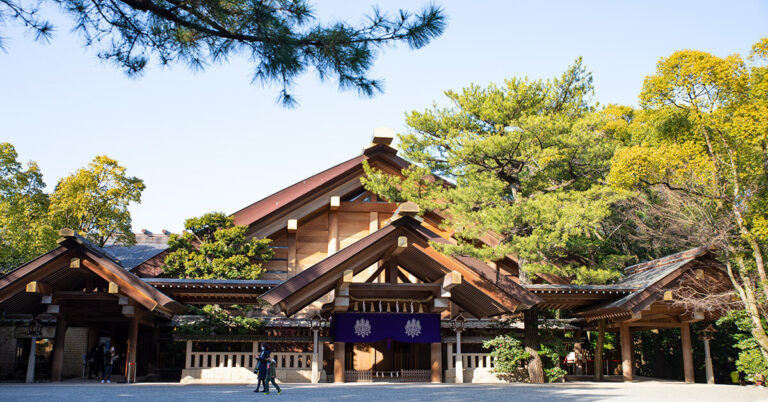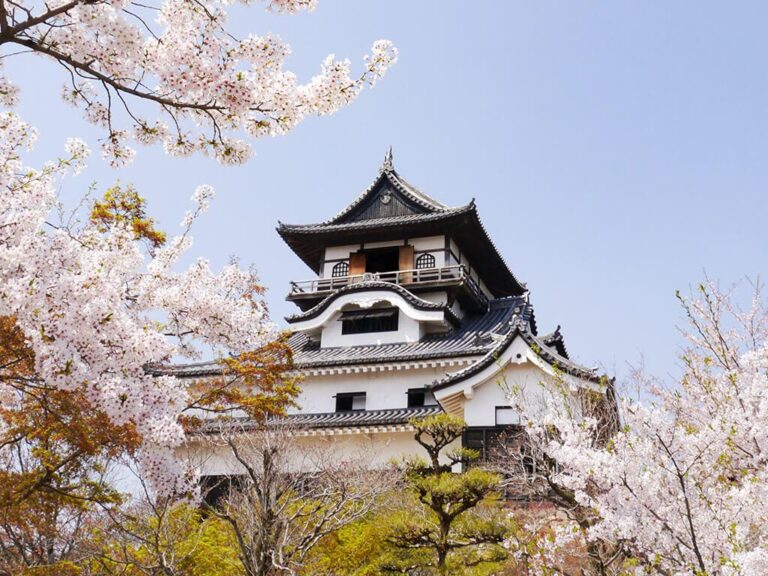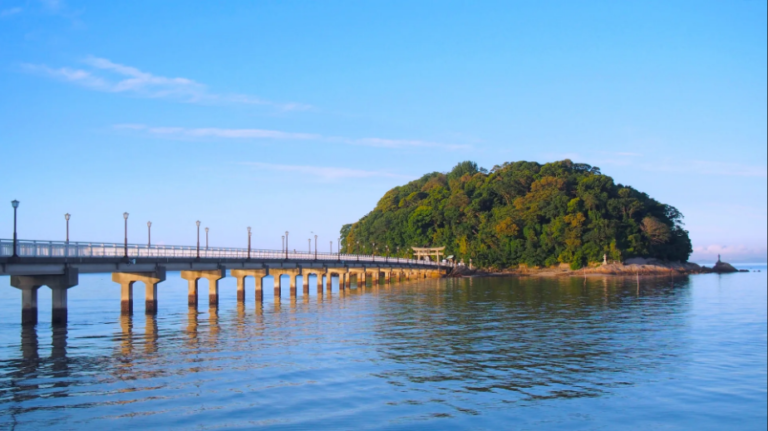Aichi's Must See Places
Nagoya Castle

Nagoya Castle, a majestic symbol of Nagoya’s rich history and cultural heritage, stands as a must-see landmark in the heart of Aichi Prefecture’s bustling capital. Constructed in the early 17th century on the orders of Tokugawa Ieyasu, the founder of the Tokugawa shogunate, this castle was not only a vital military fortress but also a pivotal political center during the Edo period. Its historical significance is immense, having played a key role in the unification and governance of Japan. Today, Nagoya Castle is celebrated for its stunning architecture, including the iconic kinshachi (golden dolphins) that adorn its rooftops, symbolizing prosperity and good fortune.
Visitors to Nagoya Castle are transported back in time as they wander through its expansive grounds and beautifully reconstructed palace buildings. The castle’s main keep, which was tragically destroyed during World War II but meticulously rebuilt in 1959, now houses a museum that showcases the castle’s history, art, and artifacts, offering insights into the lives of the samurai and nobles who once roamed its halls. The surrounding gardens, particularly vibrant in the cherry blossom season, provide a peaceful retreat from the city’s hustle and bustle. Throughout the year, the castle hosts various cultural events and festivals, allowing visitors to experience traditional Japanese culture in an authentic setting. Nagoya Castle is not just a testament to Japan’s feudal past; it’s a living, breathing cultural site that continues to captivate and educate all who walk its storied grounds.
Atsuta Shrine

Atsuta Shrine, nestled in the heart of Nagoya, Aichi Prefecture, is one of the most significant and ancient Shinto shrines in Japan, attracting millions of visitors and worshippers each year. Dating back to the first century, this venerable shrine is steeped in myth and history, housing the sacred Kusanagi-no-Tsurugi (Grass-Cutting Sword), one of the three Imperial Regalia of Japan, making it a site of profound spiritual importance. The shrine’s extensive grounds offer a serene escape from the urban environment, with towering trees, tranquil pathways, and the murmuring waters of its streams creating a peaceful haven for reflection and renewal.
Atsuta Shrine’s architectural beauty and spiritual ambiance are complemented by the various ceremonial buildings and treasure hall within its precincts, which display an array of historical artifacts and offer insights into the shrine’s rich cultural heritage. Throughout the year, Atsuta Shrine hosts numerous traditional festivals and rituals, the most famous being the Atsuta Matsuri in June, where visitors can experience vibrant processions, ceremonial dances, and martial arts demonstrations. The shrine also serves as a living cultural center, fostering the continuation of ancient Japanese traditions and crafts. Whether seeking spiritual solace, exploring Japan’s historical roots, or simply enjoying the natural beauty, Atsuta Shrine provides a unique and enriching experience that connects the past with the present in the bustling heart of Aichi Prefecture.
Inuyama Castle

Inuyama Castle, perched atop a hill overlooking the Kiso River in Aichi Prefecture, is a remarkable testament to Japan’s feudal era and a must-see destination for history enthusiasts and travelers alike. This castle, one of Japan’s oldest surviving castles, was constructed in 1537 during the Muromachi period and has stood the test of time, offering a rare glimpse into the past with its original wooden structure and architectural integrity still intact. Recognized as a National Treasure, Inuyama Castle’s historical significance is profound, having witnessed numerous battles and played a pivotal role in the power struggles of Japan’s warring states period.
Visitors to Inuyama Castle can ascend its steep wooden stairs to reach the top floor, where they are rewarded with breathtaking panoramic views of the surrounding landscape, including the meandering Kiso River and the lush, mountainous countryside. The castle’s interior is a journey through history, with exhibits of ancient weapons, armors, and artifacts that tell the tales of samurai warfare and daily life in the castle. The grounds around Inuyama Castle are equally inviting, with cherry blossoms in spring and vibrant foliage in autumn enhancing the beauty of this historic site. Throughout the year, the castle hosts various cultural events and traditional festivals, offering an immersive experience into Japan’s rich heritage. Inuyama Castle is not just an architectural marvel; it’s a symbol of resilience, history, and culture, making it an essential visit for anyone exploring the historical heart of Aichi Prefecture.
Meiji Mura

Meiji Mura, located in Inuyama, Aichi Prefecture, is an open-air museum that offers a unique journey back to the Meiji Era (1868-1912), a time of rapid modernization and westernization in Japan. This expansive park is home to over 60 historical buildings from all over Japan, carefully preserved or reconstructed here to create a vivid tableau of life during the late 19th and early 20th centuries. Among its collection are a variety of structures, from residences and government offices to churches and schools, each telling its own story of a country on the cusp of change.
Visiting Meiji Mura is like stepping into a living history book. One of its most iconic structures is the main entrance and lobby of the old Imperial Hotel, designed by the famous American architect Frank Lloyd Wright. This masterpiece of early modernist architecture showcases the fusion of Western and Japanese design elements that characterized the era. Beyond architectural marvels, Meiji Mura offers a glimpse into the daily lives of the Japanese people during the Meiji period through various cultural exhibits and demonstrations, such as traditional printing techniques and kimono dressing. The park also features vintage streetcars and a steam locomotive that visitors can ride, further enhancing the immersive experience. Meiji Mura is not just a museum; it’s a vibrant cultural experience that brings history to life, making it a must-visit destination for anyone interested in Japan’s fascinating journey from feudal isolation to international prominence.
Takeshima Island

Takeshima Island, a serene and picturesque gem, is nestled in the heart of Mikawa Bay in Aichi Prefecture. This small, yet enchanting island is easily accessible via a scenic bridge from the city of Gamagori, making it a popular escape for those looking to immerse themselves in natural beauty and tranquility. Takeshima is renowned for its rich spiritual heritage, housing the ancient Yaotomi Shrine at its peak. This shrine, dedicated to the deity Benten (or Benzaiten), goddess of music, wealth, and eloquence, is a place of worship and a site of cultural significance, drawing visitors with its peaceful atmosphere and stunning oceanic views.
The island’s natural landscape is a verdant tapestry of flora, offering a home to a variety of plant species that flourish in its mild climate. Takeshima’s pathways, winding through its lush greenery and leading to breathtaking vantage points, offer a tranquil retreat from the hustle and bustle of city life. The surrounding waters of Mikawa Bay are crystal clear, providing ideal conditions for marine life, making the island a favored spot for fishing and bird watching. Alongside its natural and spiritual allure, Takeshima is enveloped in legends and folklore, adding a mystical charm to its already captivating scenery. Whether you’re seeking spiritual solace, natural beauty, or a touch of mystery, Takeshima Island offers a unique and peaceful experience, making it a must-visit destination in Aichi Prefecture.
GHIBLI PARK

Ghibli Park offers an enchanting escape into the beloved world of Studio Ghibli, one of Japan’s most iconic animation studios. Opened to the public in November 2022, the park is a tribute to the imaginative storytelling and intricate artistry that have captured the hearts of audiences worldwide. Unlike traditional amusement parks, Ghibli Park takes a more immersive and tranquil approach, encouraging visitors to step into the worlds of Hayao Miyazaki’s films, from the whimsical charm of My Neighbor Totoro to the fantastical adventures of Spirited Away. It’s a place where reality and imagination seamlessly blend, providing an unforgettable experience for fans of all ages.
Located in Expo 2005 Aichi Commemorative Park, Ghibli Park celebrates the studio’s legacy through meticulously crafted exhibits, recreations of iconic scenes, and interactive attractions. Visitors can stroll through locations like the enchanting Ghibli’s Grand Warehouse, Dondoko Forest, and Hill of Youth, each meticulously designed to evoke the magical atmosphere of the films. The park’s commitment to environmental harmony mirrors Studio Ghibli’s themes of nature and sustainability, creating a serene environment where storytelling and the natural world coexist. Whether you’re a long-time fan of Ghibli or a newcomer discovering its charm, Ghibli Park offers a heartfelt journey into the artistry and imagination that have made Studio Ghibli a cultural treasure.